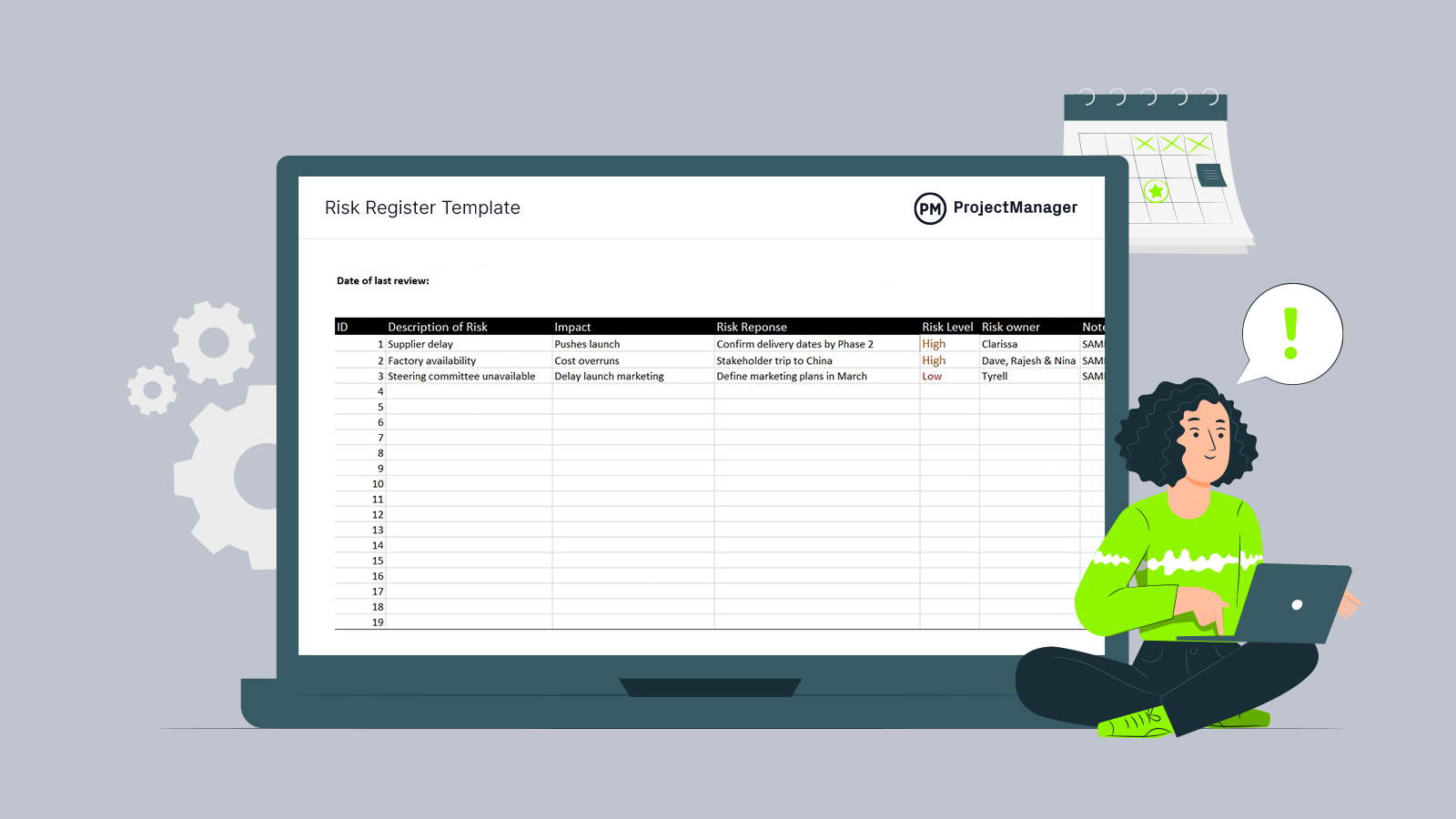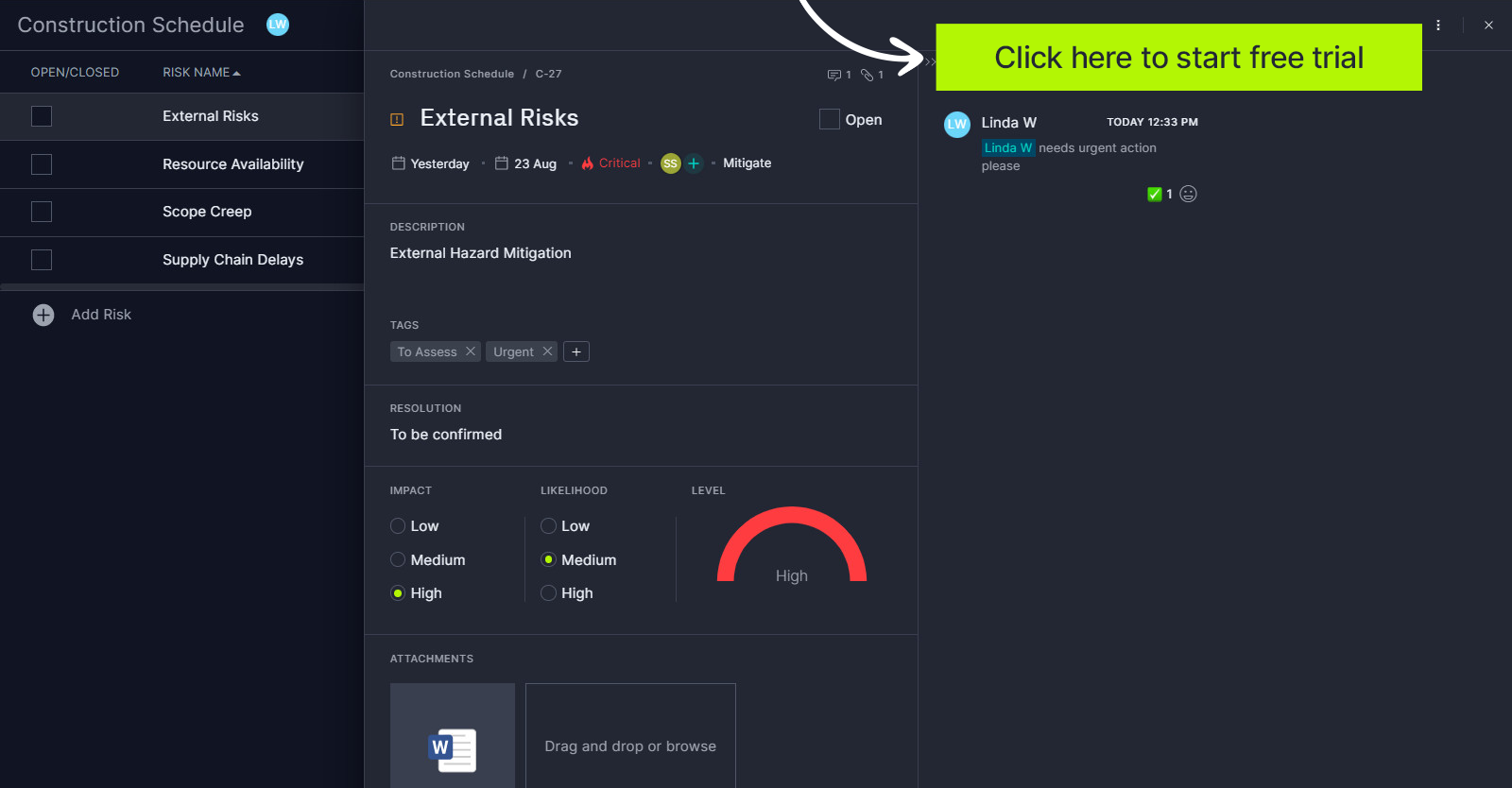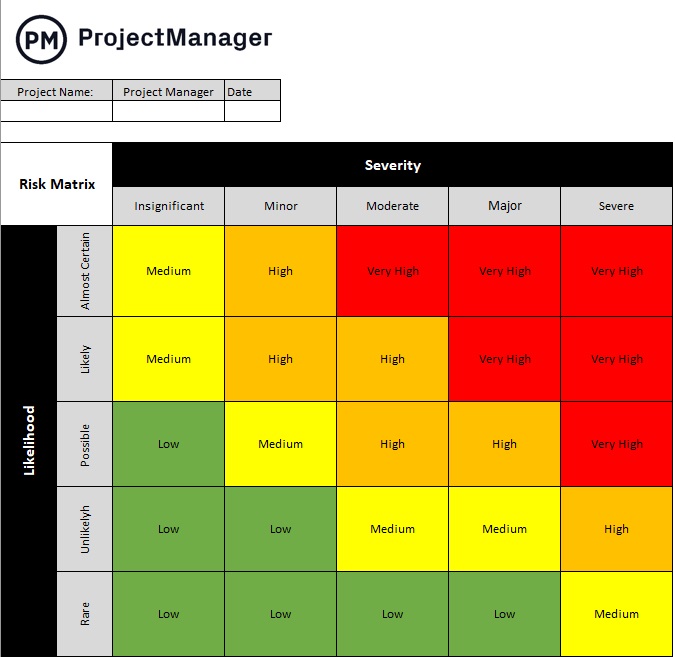Risk is something every leader knows well. No decision in any organization occurs without some potential for loss. We all need to become comfortable with some risks. We’re never going to eliminate all risks. So our best course of action is to prepare a risk mitigation plan so that we can manage those risks that are the most dangerous to our organization effectively before they have the opportunity to negatively impact us.
What Is Risk Mitigation?
Risk mitigation describes a process by which a project reduces its exposure to risk and works towards minimizing the likelihood of any issues arising during the project. It involves a process that we’ll explore in a moment but essentially addresses the top risks to fully protect the project.

Get your free
Risk Tracking Template
Use this free Risk Tracking Template for Excel to manage your projects better.
The Risk Mitigation Process
Risk mitigation is a process. We outline the five steps to this process below for planning against the unexpected in your project.
1. Identify Project Risks
The first step is to identify the risks. That might sound impossible. How do you know what is unexpected? But by seeking expert help and looking at historic data you can get a good idea of what might occur.
2. Estimate Their Impact and Likelihood
Once you have the list of risks, estimate the impact and likelihood of each. That is, if the risk shows up as an issue what will its impact on the project be and what is the likelihood of it happening?
3. Create a Risk Mitigation Plan
A risk mitigation plan is how you figure out the response to the risk if it becomes an issue. You’ll want to have it including the following.
- Risk responses: What you intend to do.
- Risk owners: Who will do it?
- Resources: What is needed to carry out the plan?
4. Monitor Risks
Always monitor the project and keep an eye out for the risks you identified or any issues that might arise. If something happens that impacts the project, then implement the plan and monitor the response until it is resolved.
5. Mitigate Risks
This is the action taken to remove the risk. Of course, there are positive risks and these are taken advantage of.
ProjectManager is award-winning project management software with risk management tools to identify and mitigate risks in products. Use our risk cards to identify and track issues. Assign the risk to team members, add priority, level of risk, response, impact and more. Get started with ProjectManager today for free.

Risk Mitigation Strategies
Naturally, there are many risk mitigation strategies that have been developed over time. Here are some of the most effective ones.
Risk Avoidance
This strategy avoids any activity that could be risky. This isn’t always possible, of course, and is best when the potential impact of the risk is high and the cost of mitigating it significant.
Risk Control
Also called risk reduction, this mitigates potential bad outcomes by enhancing safety and security. It also identifies and addresses risks before they become significant.
Risk Transference
Here the risk is transferred to another party, such as insurance to cover the cost. This is used when the risk can have a big impact, but it can also add significant cost to the project.
Risk Acceptance
As the name suggests, this is when one accepts the risk and its possible consequences without taking action. This is the best course of action when the risk is love and the cost of addressing it does not work with the benefits of mitigating the risk.
Risk Mitigation Example
In the real world, we have seen more powerful storms than ever before with Hurricane Sandy, Superstorm Sandy, and Hurricane Irma. These events have been called “100-year storms” to explain the incredible rarity of these events.
For us, we can consider them unknowns.
The way that Irma was handled in Florida is a great risk management lesson in how we should think about attacking and dealing with potentially catastrophic unknowns. The action steps are telling and instructive:
- As the storm began to consistently track toward a direct hit of Florida, Florida’s governor immediately began emergency prep, calling for evacuations, and putting a plan to mitigate risk from the storm into effect.
- With each passing day, the governor continued to advance the communications that the storm was dangerous while giving his teams the resources to evacuate populations, solidify structures, and buttress as many vulnerabilities as possible.
- During the storm, federal, state and local officials continued to monitor the storm and its impact and worked to take action as soon as it was safe to return to the streets.
- In the aftermath, the planning allowed the entire disaster relief team to move at once to rescue and repair what could be handled immediately so that they could move quickly onto the long-term rebuilding that would be needed in certain areas.
While simplistic, the example teaches us a few things about managing the risk of the unknown that can be applied in any situation.
- Monitor your environment constantly. You don’t know when an unknown is going to interrupt your project. So you have to keep a level of awareness that enables you to identify them as early as possible.
- Communicate the risk and potential implications of this unknown consistently. Because these things are rare, you often have a level of reluctance to act. You must use consistent communication to overcome this. A communication plan template can help.
- Make sure you have a way to deal with the ongoing crisis. It’s unlikely that you are going to have perfect information before or during a major You can make sure that you are doing everything to monitor the issue, control it, and use your resources effectively to manage it.
- Once the unknown risk has passed, you are going to have to recover from the disruption. This will take some creativity and some persistence. Because the risk was unknown, you won’t really know what you are dealing with until after the crisis has fully passed. This is its own form of unknown. So, make sure that you are clear about getting all the information on the table ASA Having the clearest picture of what you should overcome will enable you to take the most aggressive action to get back on a firm footing.
The key to managing the unknown is to have a plan of attack, maintain flexibility, and always make sure you are learning the reality of the situation so you can adjust your actions accordingly.
In truth, that is the key to successfully managing risk for any initiative or at any stage of project management. The likelihood of you finding a risk-free project is probably like having another unknown never disrupt another project.
Risk Mitigation Templates
ProjectManager has dozens of free project management templates for Excel and Work that can help you throughout the life cycle of your project. Here are a few that will help with risk mitigation.
Risk Register Template
Use our free risk register template for Excel to describe risks and their impact on the project. You can also detail your response, who will be responsible for carrying it out and more.

Risk Matrix Template
Our risk matrix template for Excel helps you map risk in your project by the likelihood of it happening and the severity of its impact on the project. The risk matrix is color-coded to make it easy to read at a glance.

Action Plan Template
To respond to a risk when it shows up as an issue in your project, use our action plan template for Excel. It lists all the tasks and resources you need to mitigate the risk and puts it on a timeline.

You can’t avoid risk, but you can prepare for it. One way is by equipping yourself and your team with the best tools for the job, something that can monitor and report in real-time, so when issues arise you can resolve them before they become problems. ProjectManager is online software that reports instantly on a project, reflecting team updates as they happen, allowing you the insight and speed necessary to steer your project to success. See how, by taking this free 30-day trial.

